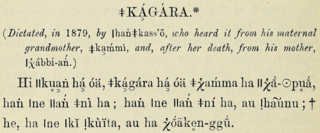Phonology
Tone
As analyzed by Sapir, [8] Jabo was represented as possessing four phonemically distinct pitch levels (or registers), [10] independent of phonation type or supraglottal articulation. Furthermore, mono-moraic (short syllable) glides from any register to any other register were phonotactically possible. This meant that there could possibly be sixteen distinct, segmentally-identical short monosyllables with significative pitch contours—more if long syllables were admitted. The not-uncommon word types CVː (CVV) and CVCV could potentially have 256 possible prosodic contours, each with a different dictionary meaning for the same three or four segments.[ citation needed ][ but are all these combinations actually allowed and contrastive? ]
Sapir devised a system of "tone letters" for specifying tone, but they are inconvenient to typeset and not included in the Unicode inventory. The common convention for Kru languages is to mark tone with subscript or superscript tone numbers following the vowel, with 1 denoting the highest register. They may also be transcribed in the IPA with tone letters or diacritics. The default tone of the language, in Jabo tone 2, is generally left unmarked in a diacritic system. As an example, take the word [ɟʱɑbo] "Jabo people", which is tone 2. For literacy purposes some system of diacritics would likely be preferable.
This article should specify the language of its non-English content, using {{ lang }}, {{ transliteration }} for transliterated languages, and {{ IPA }} for phonetic transcriptions, with an appropriate ISO 639 code. Wikipedia's multilingual support templates may also be used.(October 2021) |
| Level | Glides | |||
|---|---|---|---|---|
| High | a₁ [á] | (a₁₂) | (a₁₃) | (a₁₄) |
| Mid | a₂ [a] | a₂₁ | (a₂₃) | (a₂₄) |
| Low | a₃ [à] | a₃₁ | a₃₂ | (a₃₄) |
| Bottom | a₄ [ȁ] | a₄₁ | a₄₂ | a₄₃ |
Falling contour tones (parentheses) are very rare. Where they occur, they seem to be in imitation of other languages or dialects. [9]
Vowels
The vowels marked with a subscript dot are said to be "dark" or "turbid". This is usually understood as being due to an articulation with pharyngeal [11] constriction. Advanced tongue root position or faucalization may also be involved. This last possibility may make it simpler to rationalize the apparent markedness of the extreme vowels [u] and [i], which are said always to be "turbid".
Nasalized versions of [ɛˤ],[ɔˤ], and [aˤ] were reported, but it is doubtful whether they have phonemic status. Since the articulations involved are probably to a degree mutually exclusive (velic and pharyngeal), and since they seem to contribute similar auditory components (nasalization and "turbidity"), they are more likely to be allophones resulting from assimilation. Sapir was an excellent phonetician, so his transcriptions may be narrowly accurate, whatever their phonological implication. In the case of Herzog or Blooah, one suspects that there may have been a normalization attempt by the transcriber. This nonetheless gives an appearance of vowel harmony to Jabo phonology.
| Front | Mid | Back | |||||||
|---|---|---|---|---|---|---|---|---|---|
| plain | nasal | pharyn- geal | plain | nasal | pharyn- geal | plain | nasal | pharyn- geal | |
| High | i | ĩ | u | ũ | |||||
| High-Mid | e | ẽ | eˤ | o | õ | oˤ | |||
| Low-Mid | ɛ | ɛ̃ | ɛˤ | ɔ | ɔ̃ | ɔˤ | |||
| Low | a | ã | aˤ | ||||||
Syllabic nasals [m̩] and [n̩] also occur. Related to this is a phenomenon of prenasalization, termed "anacrusis" by Sapir by analogy with the metrical term. It is probably best accounted for systematically by an underlying syllabic nasal, since it occurs with some approximants, as well as with voiced plosives.
Consonants
| Labial | Alveolar | Retroflex | Palatal | Velar | Labial- velar | Glottal | ||
|---|---|---|---|---|---|---|---|---|
| Plosive | voiceless | p | t | c | k | k͡p | ||
| voiced | b | d | ||||||
| breathy | bʱ⟨b⟩ | dʱ⟨d⟩ | ɟʱ⟨j⟩ | ɡʱ⟨g⟩ | ɡ͡bʱ⟨gb⟩ | |||
| Fricative | voiceless | f | s | ʃ ⟨ṣ⟩ | h | |||
| breathy | v̤⟨v⟩ | z̤⟨z⟩ | ʒ̤⟨ẓ⟩ | |||||
| Nasal | m | n | ɳ ⟨ṇ⟩ | ɲ ⟨ñ⟩ | ŋ | ŋ͡m ⟨ŋm⟩ | ||
| Approximant | w | l | j ⟨y⟩ | |||||
The forms enclosed in brackets show the orthography used by Sapir/Herzog; other forms are the same.
Segments [ʃ],[ʒ],[l] and [ɳ] probably have only allophonic status. Word initial [l] occurs only in loans from English. The retroflex nasal occurs in only a single word, but that word [ɳa] meaning "possessive" is very common.
Consonants here called "breathy" are those termed "emphatic" by Sapir. [11] The plosives are here marked with a superscript hooked h ([ʱ]), while the continuants are marked with a subscript diaeresis. The contrastive use of this feature defines a major isogloss separating Jabo from Glebo. [12]






